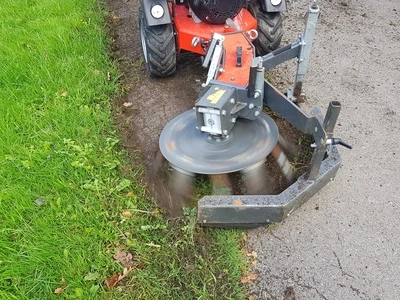
Creating a weed control strategy for all seasons; Pesticide Free
News about Weed Control Item Code: News 43
If you are used to a spraying schedule, then putting together another sort of Weed elimination strategy can be a bit daunting. But if you go back to basics, it's quite simple.
Weeds use a combination of natural processes to grow. If we can disrupt these processes we can eliminate the weeds effectively.
1. The soil cycle.
It is soil which provides most of the nutrients and water storage that gives weeds the opportunity to grow on hard surfaces. A clean hard surface such as tarmac or block paving has no nutrients to offer an opportunistic weed.
But how does the soil get there?
This video gives us a good display of what occurs over the course of just a couple of months to organic matter from trees, grass, hedges and other plant sources when it is left to decompose.
In the Summer and Autumn, organic debris is constantly being left on the surface in the form of grass cuttings, hedge clippings, leaves etc. When these decompose into soil, it gives an opportunity for weeds to grow.
The easiest way to reduce weeds is by eliminating these opportunities. Collecting detritus shortly after it is dropped by vacuuming or sweeping is a simple way to tackle this. When the soil is firmly established, such as a build up on path edges, or in gaps between block paving then it must be removed by another method such as weed brushing.
Weed brushing can be done in the winter. All the annual plants will be gone, so it is easier to see the offending soil and remaining established weeds. Doing this in winter also gives you a head start, as the first new weeds won't begin to grow until spring. If they have nothing to grow in, you have won half the battle already.
2. The plant life cycle.
While plants life cycles are continuous, a plant’s life begins with the seed. With water, right temperature and right location, the seed grows. It becomes a seedling. Roots push down into the ground to get water and minerals. The stem reaches for the sun, and leaves begin to unfold. A bud appears. The plants then produce flowers. The flowers are then pollinated in many ways – by bees, moths, butterflies, insects, moths, bats, butterflies and even by the wind. The pollinated flower turns into fruit. The new seeds are inside the fruit. The ripe fruit drops to the ground and the cycle begins again.

For annual plants the plant life cycle will all happen within a few months. Our best chance at interrupting this cycle and preventing new growth is to eliminate the plant before it seeds.
Most seeds will germinate and begin to grow in the spring and will be dropping seeds by late summer. Therefore, the best time to kill the plant is in spring. We can do this in one of several ways.
- A plant needs; Light, Air, Water, Nutrients and Warmth in order to survive. We can kill a plant by depriving it of any of these things.
If a plant has soil, it is quite difficult to deprive the plant of water, nutrients, water and warmth when it is outside. The easiest one to go for is light. We can do this either by;
- Covering the plant so that no light can reach it.
- Destroying the chlorophyll in the plant which does the job of processing the sunlight and turning it into energy (Photosynthesis).
Option 2 is by far the more viable for larger areas and can be achieved by exposing the plant to high temperatures.

A common misconception is that the plant has to be visibly scorched before it will suffer. The fact is, a plant leaf only has to be briefly exposed to a temperature of around 80°C to suffer terminal damage. This exposure to severe heat bursts the cells in the plant leaf. This in turn renders the plant incapable of converting light energy in to chemical energy (Photosynthesis) effectively causing starvation.
Further thought and research on this subject will reveal this method is most effective on young, fleshy, hungry plants rather than old established woody plants, which may have sufficient amounts of stored energy in their stems and roots to overcome temporary food shortages. The earlier in the plant life cycle we treat the plant, the more effective the treatment will be.
As plants emerge at different times in spring and different plants will take varying numbers of treatments due to the energy stored in the roots, it is good practise to carry out several treatments of heat throughout the spring season.
From all this knowledge we can determine the most effective strategy for weed elimination.
The effective regime;
Winter - Weedbrushing and collection of soil, which will prevent opportunities for weed growth.
Spring - Several treatments with heat such as a weed burner, which will kill the emerging weeds before they seed.
Summer - Sweeping grass cuttings, hedge clippings and other organic debris to prevent this from being allowed to decompose and form more soil.
Autumn - Collecting dead leaves and other organic debris that naturally falls from deciduous and annual plants in Autumn to prevent this from being allowed to decompose and form more soil.
For more information about maintaining surfaces; check out our surface maintenance handbook click here.